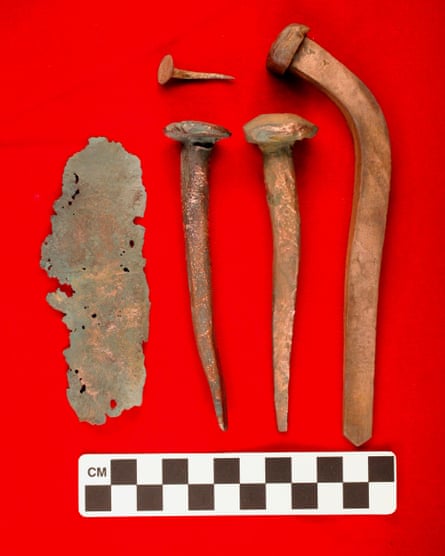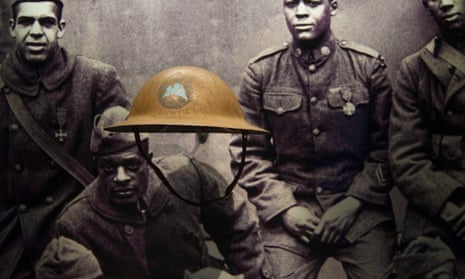Jesse Jackson walked through galleries chronicling African Americans’ enslavement, long struggle for freedom and achievements in culture, science, sport and politics. “I wish Dr King were here today,” the veteran civil rights activist said quietly. “Just for a moment.”
Reverend Jackson joined media from around the world on Wednesday for a preview of the $540m Smithsonian National Museum of African American History and Culture, which will be formally opened next week by the country’s first black president, Barack Obama.
So prominent is the distinctive structure on the national mall in Washington – dubbed “America’s front yard” – that its architects were told by the secret service to ensure that it could not be used by snipers to target the White House.
From Harriet Tubman’s hymn book to a slave cabin from South Carolina, from Muhammed Ali’s boxing gloves to Carl Lewis’s gold medals, from a metal bucket used to bathe the feet of Martin Luther King to tiny shoes worn by Sammy Davis Jr as a child dancer, the museum is a tour de force of more than 3,000 artifacts with a mission statement to “tell the unvarnished truth”.
As Jackson walked the galleries, he caught a glimpse of himself in some old film footage. “You missed my momma’s son!” the 74-year-old told a reporter.
But he was sombre as he reflected on all those in the museum who will never have the chance to see it. “I kind of feel the way I did the night that Barack won and I cried ‘cos I wished Dr King had been there just to peep at it for 15 seconds. I wish my father who served in world war two were here. I wish those I grew up with were here. But what a joy it is to see this.”

Jackson toured a sports gallery that includes heavyweight boxers Jack Johnson and Joe Louis’s boxing gloves, sprinter Jesse Owens’s track shoes from the 1936 Olympics in Berlin, Jackie Robinson’s baseball bat, Michael Jordan’s Chicago Bulls jersey and Tiger Woods’ golf cap and shirt.
The civil rights campaigner, who twice ran for president, said: “Why are we so great in athletics, why are we so dominant in athletics, often without the best training, often the roughest fields? Five basic reasons: when the playing field is even, and the rules are public, and the goals are clear and the referees are fair and the score is transparent, we can make it. If that applied to medicine, law, technology and banking we’d be as significant there as we are in athletics.”
In the museum’s centrepiece gallery, which hauntingly explores the story of slavery and freedom, Jackson reflected: “It reshuffles the deck of American history. It teaches us that light illuminates darkness. The truth of the African American existence must finally be told. There’s been a great denial of the African role in American history and western history.
“All those who got PhDs before in history – all those white professors and black professors – must come back here to get their degree recertified. Any history that does not include this history is not American history; it’s white history and we need to have an authentic American history from the bottom up, not the top down.”
A short distance away from Jackson as he spoke was a statue of Thomas Jefferson – unlike the nearby heroic Jefferson Memorial, against the backdrop of a wall bearing the names of slaves he owned. A caption notes that “slavery was woven into his daily life, as were its contradictions”, and states unequivocally that America’s third president fathered a child with slave Sally Hemings when she was 17.
Co-curator Mary Elliott acknowledged that this could be controversial with a minority of historians who seek to defend Jefferson. “It would not be a surprise. Part of the reason we have this is to talk through this unvarnished truth, tells these stories, because this is part of who we are.”
She added: “It’s part of this human story. Here’s this man during this period wrestling with these very important issues during his time, no different from the way President Obama wrestles with issues today, so we have to tell the unvarnished truth. He’s wrestling with these issues yet he still held enslaved people and had children by them. So it’s important we talk about everyone from a human perspective but also he’s pivotal to shaping the nation.”

Emotions run high in the slavery and freedom gallery, located underground, and there will be signs advising parents on whether the material is suitable for children. “What’s been the important thing to me, or one of the most moving things, is seeing the journalists walk through and on their personal level you can see their faces go, ‘OK, wow!’,” said Elliott. “That’s been really exciting to see. To remove that veil and see the person who actually is looking at it.”
For Elliott, one of the most powerful objects is an auction block, “a site of fear, humiliation and uncertainty” where slaves were bought and sold and separated from their loved ones for life. In a nearby display case is a whip used to punish slaves.
“The energy that was in that. I’ve never been one that was like, ‘I wonder what it’s like to hold a whip,’ but I was curious when it came out and I was so blown away looking at it, and then when I picked it up it was very powerful because it’s very heavy. To design an object specifically to beat a person, and then to have it in your hand and strategically think where am I going to hit this person? That just blew me away.”

The section also includes timber and iron ballast recovered from the ocean floor after the sinking in 1794 of the São José, a Portuguese slave ship that sank 300ft off the coast of South Africa with at least 200 fatalities.
Other notable exhibits in the museum include an Angola Prison Guard Tower, a segregation-era railway carriage, the orange silk jacket and black velvet skirt worn by singer Marian Anderson during her Easter Sunday performance on the steps of the Lincoln Memorial in 1939, a dress that Rosa Parks was making shortly before her arrest for not giving up her seat on a segregated bus, and the the casket of Emmett Till, whose 1955 murder in Mississippi helped galvanise the civil rights movement.
There is a glass case devoted to Obama’s 2008 election victory, including a dress worn by Michelle Obama who, in a speech at this year’s Democratic national convention, referred to waking up each day in a White House that itself had been built by slaves. The Obamas were given a private 80-minute tour of the museum on Wednesday before heading out to dinner.
Exhibits also include wrought-iron shackles and a Ku Klux Klan mask, as well as retired general and former secretary of state Colin Powell’s military uniform and Dr Ben Carson’s lab coat and surgical scrubs. A caption states that Carson “overcame poverty and failing grades to become one of the world’s most distinguished pediatric neurosurgeons” and notes that after retiring from medicine in 2013, “he embarked on a career in national politics” but does not mention his run for president or his support for Donald Trump.
The culture galleries display a red Cadillac convertible belonging to rock‘n’roll pioneer Chuck Berry, a fedora worn by Michael Jackson and costumes from the musical The Wiz. Comedian Bill Cosby features prominently in footage and album cover but a caption notes: “In recent years, revelations about alleged sexual misconduct have cast a shadow over Cosby’s entertainment career and severely damaged his reputation.”
A section on comedian Richard Pryor records that he sparked controversy for his frequent use of the word “nigger” in his comedy routines. “In 1980 Pryor told Ebony magazine that a trip to Kenya had convinced him to stop using the word: ‘There are no ‘niggers’ in Africa, and there are no ‘niggers’ here in America either.’”
The museum walls are sprinkled with pithy and poignant quotations. One from playwright August Wilson says: “The message of America is, ‘Leave your Africanness outside the door.’ My message is, ‘Claim what is yours’.”
The museum contrasts with yet complements the white marble, granite and concrete of other Smithsonian buildings on the mall. Its exterior “corona” consists of 3,600 bronze-coloured cast aluminium panels weighing a total of 230 tonnes and drawing on imagery from both African and American history. The lead designer was Tanzanian-born British architect David Adjaye.
Philip Freelon, president of the Freelon Group, the lead architecture firm on the project, said: “We have sight lines to the White House and the secret service wanted to make sure there weren’t any balconies where a sniper could sit and zero in on the White House. When we stopped to think about it, we saw the value in that approach. It makes sense.”

The sight of crowds moving through was a moment to savour for Lonnie Bunch, the museum’s founding director. “It’s hard for me to remember but 11 years ago we really did start this with a staff of two, with no collections at all,” he said.
“We really had even no idea where the site of the museum would be ... All we knew is that we had a vision. A vision that we wanted to help all encountered the museum to remember, to remember the rich history of the African American.”
Black civil war veterans first proposed an African American museum in 1915. Congress approved its creation in 2003, and construction of the 400,000 sq ft building took almost four years.
On Wednesday workmen were still putting the finishing touches to some exhibits, the shop was empty and a few journalists on the top found neither the lift nor escalator could bring them down. But asked if the museum would be completed on schedule, Bunch smiled: “We are so ready it’s ridiculous. We’ve got 10 days? It’s a piece of cake.”

Comments (…)
Sign in or create your Guardian account to join the discussion